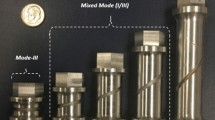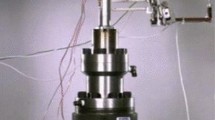Abstract
Background
The effect of loading rate on the fracture properties of materials had been the subject of interest for more than four decades. However, the effect of loading rates on Mixed-mode fracture, involving Modes I and III, is known little due to the complexity of loading conditions and the inertia effect at a high loading rate.
Objective
The main objective is to develop a framework to investigate the relationship between loading rate and fracture parameter under Mixed-mode (I/III) loading conditions using a novel laboratory setup.
Methods
Experimentally, a modified spiral Notched specimen, stereo-digital image correlation, and a torsional Hopkinson bar apparatus are employed to characterize the dynamic fracture response of materials subjected to a combined torsion and tension loading. Specimens with different gauge lengths were used to generate low, intermediate, and high loading rates associated with Mixed-mode (I/III) notch tip conditions. Numerically, finite element analyses were performed to calculate the dynamic stress intensity factor using the dynamic interaction integral approach.
Results
The fracture initiation time was seen to be related to the spiral angle. It was found that the Mixed-mode fracture initiation toughness increase with the loading rate. For Aluminum 2024-T3, the dynamic fracture initiation toughness under Mode-III is threefold smaller than the Mode-I condition.
Conclusions
The proposed approach, dynamic tension–torsion loading of a spirally notched specimen, successfully generates a range of loading rates on Mixed-mode fracture involving Modes I and III conditions. The dynamic integral method was effectively used to extract fracture parameters at different loading rates and conditions. Therefore, the proposed approach is a promising method for investigating the dynamic Mixed-mode fracture of materials involving Mode I and III conditions.












Similar content being viewed by others
Abbreviations
- \(J\) :
-
J-integral (Strain energy release rate)
- \({K}_{\mathrm{I}},{ K}_{\mathrm{II}}, {K}_{\mathrm{III}}\) :
-
Stress intensity factors of Mode-I, Mode-II and Mode-III respectively
- \({K}_{\mathrm{Ic}},{ K}_{\mathrm{IIc}}, {K}_{\mathrm{IIIc}}\) :
-
Static fracture toughness of Mode-I, Mode-II, and Mode-III respectively
- \({K}_{\mathrm{Id}},{ K}_{\mathrm{IId}}, {K}_{\mathrm{IIId}}\) :
-
Dynamic fracture toughness of Mode-I, Mode-II, and Mode-III respectively
- \({\tau }_{\mathrm{max}}\) :
-
Maximum shear stress
- \({\sigma }_{\mathrm{max}} , {\sigma }_{\mathrm{min}}\) :
-
Maximum and minimum principle stress
- \(\dot{K}\) :
-
Fracture loading rate
- \({t}_{\mathrm{f}}\) :
-
Fracture initiation time
- \({\tau }_{1}\) :
-
Characteristic of the minimum oscillation of the specimen
- \({\gamma }_{\mathrm{i}} , {\gamma }_{\mathrm{r}} ,{\gamma }_{\mathrm{t}}\) :
-
Incident, reflected, and transmitted strain waves respectively
- \(U, V, W\) :
-
Displacement along x, y and z directions respectively
- \(MOD\) :
-
Mouth opening displacement
- \({\sigma }_{\mathrm{ij}}^{\mathrm{aux}}\) :
-
Auxiliary stress tensor around the crack tip
- \({\varepsilon }_{\mathrm{ij}}^{\mathrm{aux}}\) :
-
Auxiliary strain tensor around the crack tip
- \({u}^{\mathrm{aux}}\) :
-
Auxiliary displacement
- \({\varepsilon }_{\mathrm{ij}}\) :
-
Strain tensor
- \(\mathrm{det}J\) :
-
Determinant of Jacobian matrix
- \({\beta }_{\mathrm{sp}}\) :
-
Inclined angle of notch spiral path measured from center of the specimen
- \(\overline{K }\) :
-
Polar second moment of area of hollow bar
References
Kim Y, Chao YJ (2007) Effect of loading rate on dynamic fracture initiation toughness of brittle materials. Int J Fract 145:195–204
Ravi-Chandar K (2004) Dynamic Fracture, First edit. Elsevier Ltd, Netherlands
Wiesner CS, Macgillivray H (1999) Loading Rate Effects on Tensile Properties and Fracture Toughness of Steel. TWI 5–7. https://www.twi-global.com/
Jiang F, Vecchio KS (2009) Hopkinson Bar Loaded Fracture Experimental Technique: A Critical Review of Dynamic Fracture Toughness Tests. Appl Mech Rev 62:1–39
Aliha MRM, Bahmani A, Akhondi S (2015) Determination of mode III fracture toughness for different materials using a new designed test configuration. Mater Des 86:863–871. https://doi.org/10.1016/j.matdes.2015.08.033
Aliha MRM, Bahmani A, Akhondi S (2016) A novel test specimen for investigating the mixed mode I+III fracture toughness of hot mix asphalt composites - Experimental and theoretical study. Int J Solids Struct 90:167–177
Aliha MRM, Bahmani A (2017) Rock Fracture Toughness Study Under Mixed Mode I/III Loading. Rock Mech Rock Eng 50:1739–1751. https://doi.org/10.1007/s00603-017-1201-7
Bahmani A, Farahmand F, Janbaz MR et al (2021) On the comparison of two mixed-mode I + III fracture test specimens. Eng Fract Mech 241:107434. https://doi.org/10.1016/j.engfracmech.2020.107434
Wang JA, Liu KC (2004) A New Approach to Evaluate Fracture Toughness of Structural Materials. J Press Vessel Technol 126:534–540
Wang JA, Liu KC (2003) Fracture Toughness Determination Using Spiral-Grooved Cylindrical Specimen and Pure Torsional Loading. United States Pat pplication-6588286B2
Tan T, Ren F, Wang JJA et al (2013) Investigating fracture behavior of polymer and polymeric composite materials using spiral notch torsion test. Eng Fract Mech 101:109–128. https://doi.org/10.1016/j.engfracmech.2012.07.007
Liu C, Knauss WG, Rosakis a J, (1998) Loading Rates and The Dynamic Initiation Toughness in Brittle Solids. Int J Fract 90:103–118. https://doi.org/10.1023/A:1007447603177
Osovski S, Srivastava A, Ponson L et al (2015) The effect of loading rate on ductile fracture toughness and fracture surface roughness. J Mech Phys Solids 76:20–46. https://doi.org/10.1016/j.jmps.2014.11.007
Zhang QB, Zhao J (2013) Effect of loading rate on fracture toughness and failure micromechanisms in marble. Eng Fract Mech 102:288–309. https://doi.org/10.1016/j.engfracmech.2013.02.009
Zhou L, Zhu Z, Qiu H et al (2018) Study of the effect of loading rates on crack propagation velocity and rock fracture toughness using cracked tunnel specimens. Int J Rock Mech Min Sci 112:25–34. https://doi.org/10.1016/j.ijrmms.2018.10.011
Bažant ZP, Shang-Ping B, Ravindra G (1993) Fracture of rock: Effect of loading rate. Eng Fract Mech 45:393–398. https://doi.org/10.1016/0013-7944(93)90024-M
Fahem A, Kidane A, Sutton M (2019) Geometry Factors for Mode I Stress Intensity Factor of a Cylindrical Specimen with Spiral Crack Subjected to Torsion. Eng Fract Mech 214:79–94. https://doi.org/10.1016/j.engfracmech.2019.04.007
Fahem A, Kidane A (2019) A Progression on the Determination of Dynamic Fracture Initiation Toughness Using Spiral Crack. Fract Fatigue, Fail Damage Evol Conf Proc Soc Exp Mech Ser 6:89–95. https://doi.org/10.1007/978-3-319-95879-8_15
Fahem A, Kidane A (2017) A General Approach to Evaluate the Dynamic Fracture Toughness of Materials. Dyn Behav Mater Conf Proc Soc Exp Appl Mech 1:185–194. https://doi.org/10.1007/978-3-319-41132-3_26
Fahem A (2019) Using a Nondispersive Wave Propagation for Measuring Dynamic Fracture Initiation Toughness of Materials : Experimental and Numerical Based Study (Doctoral dissertation). USC, Retrieved from https://scholarcommons.sc.edu/etd/5581
Fahem A, Kidane A, Sutton MA (2019) Mode-I Dynamic Fracture Initiation Toughness Using Torsion Load. Eng Fract Mech 213:53–71. https://doi.org/10.1016/j.engfracmech.2019.03.039
Fahem A, Kidane A, Sutton MA (2020) Method to Determine Mixed-mode(I/III) Dynamic Fracture Toghness of Materials. Pat Appl Publ Patent US-2020/0408657-A1
Fahem A, Kidane A (2018) Modification of Benthem Solution for Mode I Fracture of Cylinder with Spiral Crack Subjected to Torsion. Soc Exp Mech 57–63. https://doi.org/10.1007/978-3-319-95879-8_10
Deng X (1994) The Asymptotic Structure of Transient Elastodynamic Fields at the Tip of a Stationary Crack 446:1–13
Freund LB (1990) Dynamic Fracture Mechanics. Cambridge University Press, Cambridge University Press
Dieter G (1961) Mechanical metallurgy, 3rd edn. McGraw-Hill, United States of America
Fahem A, Kidane A, Sutton MA (2020) A Novel Method to Determine the Mixed Mode ( I / III ) Dynamic Fracture Initiation Toughness of Materials. Inernational Fract Mechincs 224:47–65. https://doi.org/10.1007/s10704-020-00445-3
Fahem A, Kidane A (2019) Mixed Mode (Mode I/III) Dynamic Fracture Initiation Youghness of Aluminum Alloy. In: Challenges in Mechanics of Time Dependent Materials,Fracture, Fatigue, Failure and Damage. pp 59–46
Chen W, Bo S (2011) Split Hopkinson(Kolsky) Bar Design. Springer, Testing and Application
Naik NK, Asmelash A, Kavala VR, Ch V (2007) Interlaminar Shear Properties of Polymer Matrix Composites : Strain rate effect. Mech Mater 39:1043–1052
Correlated Solution Inc. (2020) www.correlatedsolutions.com. Armo, SC, USA. www.correlatedsolutions.com
Brahma KK, Dash PK, Dattaguru B (1989) Observation of crack closure using a crack mouth ipening displacement gauge 1:37–41
Sutton MA (2007) Three-Dimensional Digital Image Correlation to Quantify Deformation and Crack-Opening Displacement in Ductile Aluminum Under Mixed-Mode I/III Loading. Opt Eng 46:051003
Sutton MA, Orteu JJ, Schreier HW (2009) Image Correlation for Shape, Motion and Deformation Measurements- Basic Concepts, Theory and Applications. Image Rochester NY 341
Dodds RH, Vargas PM (1988) Numerical Evaluation of Domain and Contour Integrals for Nonlinear Fracture Mechanics: Formulation and Implementation Aspects. Urbana-Champaign
Vargas P, Robert Jr HD (1993) Three-Dimensional. Univ Illinois Urbana-Champaign, Inelastic Response of Single-Edge Notch Bend Specimens Subjected to Impact Loading, p 209
Kuna M (2013) Finite Elements in Fracture Mechanics Theory-Numerics-Applications. Springer, Dordrecht Heidelberg New York London
Simulia DS (2017) ABAQUS FEA. Dassault Systèmes Simulia Corp, USA
Fahem A, Kidane A (2018) Hybrid Computational and Experimental Approach to Identify the Dynamic Initiation Fracture Toughness at High Loading Rate. Dyn Behav Mater Conf Proc Soc Exp Mech 1:141–146. https://doi.org/10.1007/978-3-319-62956-8_24
Kolsky H (1963) Stress Waves in Solids. Dover Publications Inc, New York, NY
Rao SS (2017) Mechanical vibrations, Sixth. Pearson
Liu S, Chao YJ, Zhu X (2004) Tensile-shear transition in mixed mode I/III fracture. Int J Solids Struct 41:6147–6172. https://doi.org/10.1016/j.ijsolstr.2004.04.044
Xu Z, Li Y (2008) Research on mode-I and mode-II dynamic fracture in high strength steels under high loading rates. Adv Mater Res 33–37 PART:351–356. https://doi.org/10.4028/www.scientific.net/AMR.33-37.351
Owen D, Zhuang S, Rosakis A, Ravichandran G (1998) Experimental Determination of Dynamic Crack Initiation and Propagation Fracture Toughness in Thin Aluminum Sheets. Int J Fract 90:153–174
Acknowledgements
The support of the University of South Carolina and Mr. Edward Walton, Chief Financial Officer, to provide significant matching funds for development of a multiaxial loading laboratory is deeply appreciated.
Author information
Authors and Affiliations
Corresponding author
Ethics declarations
Conflict of Interests
The authors declare no conflict of interests.
Research Involving Human and Animal Participants
The research conducted in this work did not involve human participants or animals and all authors have read and consented to the final version of the manuscript.
Additional information
Publisher's Note
Springer Nature remains neutral with regard to jurisdictional claims in published maps and institutional affiliations.
Rights and permissions
About this article
Cite this article
Fahem, A., Kidane, A. & Sutton, M. Loading Rate Effects for Flaws Undergoing Mixed-Mode I/III Fracture. Exp Mech 61, 1291–1307 (2021). https://doi.org/10.1007/s11340-021-00739-0
Received:
Accepted:
Published:
Issue Date:
DOI: https://doi.org/10.1007/s11340-021-00739-0




